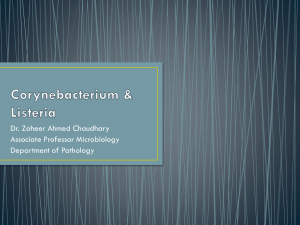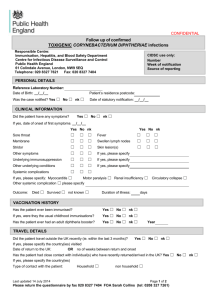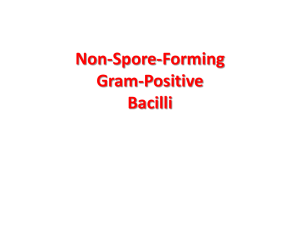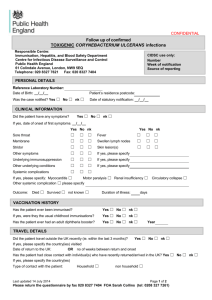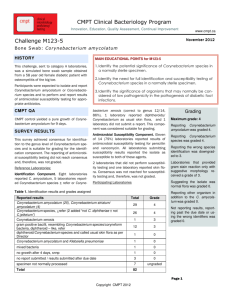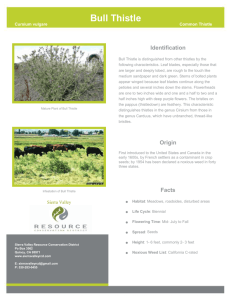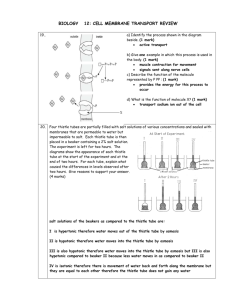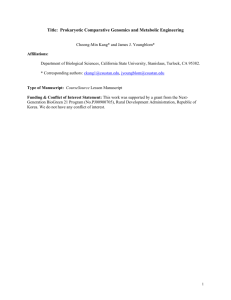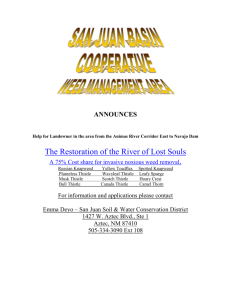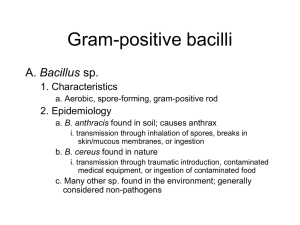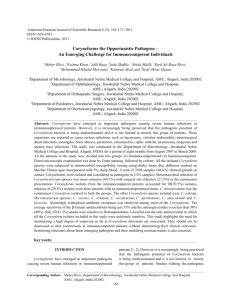Cycle 36 Organism 5 - Corynebacteria
advertisement
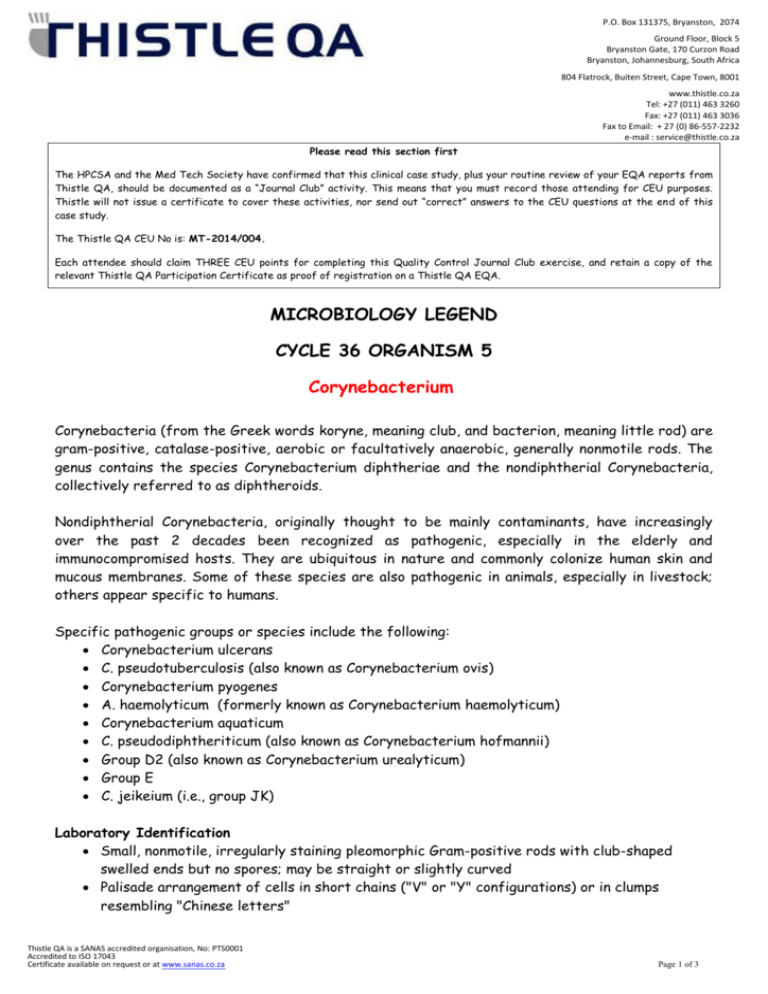
P.O. Box 131375, Bryanston, 2074 Ground Floor, Block 5 Bryanston Gate, 170 Curzon Road Bryanston, Johannesburg, South Africa 804 Flatrock, Buiten Street, Cape Town, 8001 www.thistle.co.za Tel: +27 (011) 463 3260 Fax: +27 (011) 463 3036 Fax to Email: + 27 (0) 86-557-2232 e-mail : service@thistle.co.za Please read this section first The HPCSA and the Med Tech Society have confirmed that this clinical case study, plus your routine review of your EQA reports from Thistle QA, should be documented as a “Journal Club” activity. This means that you must record those attending for CEU purposes. Thistle will not issue a certificate to cover these activities, nor send out “correct” answers to the CEU questions at the end of this case study. The Thistle QA CEU No is: MT-2014/004. Each attendee should claim THREE CEU points for completing this Quality Control Journal Club exercise, and retain a copy of the relevant Thistle QA Participation Certificate as proof of registration on a Thistle QA EQA. MICROBIOLOGY LEGEND CYCLE 36 ORGANISM 5 Corynebacterium Corynebacteria (from the Greek words koryne, meaning club, and bacterion, meaning little rod) are gram-positive, catalase-positive, aerobic or facultatively anaerobic, generally nonmotile rods. The genus contains the species Corynebacterium diphtheriae and the nondiphtherial Corynebacteria, collectively referred to as diphtheroids. Nondiphtherial Corynebacteria, originally thought to be mainly contaminants, have increasingly over the past 2 decades been recognized as pathogenic, especially in the elderly and immunocompromised hosts. They are ubiquitous in nature and commonly colonize human skin and mucous membranes. Some of these species are also pathogenic in animals, especially in livestock; others appear specific to humans. Specific pathogenic groups or species include the following: Corynebacterium ulcerans C. pseudotuberculosis (also known as Corynebacterium ovis) Corynebacterium pyogenes A. haemolyticum (formerly known as Corynebacterium haemolyticum) Corynebacterium aquaticum C. pseudodiphtheriticum (also known as Corynebacterium hofmannii) Group D2 (also known as Corynebacterium urealyticum) Group E C. jeikeium (i.e., group JK) Laboratory Identification Small, nonmotile, irregularly staining pleomorphic Gram-positive rods with club-shaped swelled ends but no spores; may be straight or slightly curved Palisade arrangement of cells in short chains ("V" or "Y" configurations) or in clumps resembling "Chinese letters" Thistle QA is a SANAS accredited organisation, No: PTS0001 Accredited to ISO 17043 Certificate available on request or at www.sanas.co.za Page 1 of 3 P.O. Box 131375, Bryanston, 2074 Ground Floor, Block 5 Bryanston Gate, 170 Curzon Road Bryanston, Johannesburg, South Africa 804 Flatrock, Buiten Street, Cape Town, 8001 www.thistle.co.za Tel: +27 (011) 463 3260 Fax: +27 (011) 463 3036 Fax to Email: + 27 (0) 86-557-2232 e-mail : service@thistle.co.za Cells tend to lie parallel to one another (palisades) or at acute angles (coryneforms), due to their snapping type of division Vary greatly in dimension, from 0.3 to 1 um in diameter and 1.0 to 8.0 um in length May also contain inclusion bodies, known as metachromatic granules, which are composed of inorganic polyphosphates (volutin) that serve as energy reserves and are not membrane bound Internal metachromatic granules densely stain ruby red while the rest of the bacillus stains blue, when stained with an aniline dye such as toluidine blue O or methylene blue Cells appear to be banded or beaded with irregularly staining granules; may show alternate bands of stained and unstained material (giving the appearance of septa) Aerobic or facultatively anaerobic Fermentative metabolism (carbohydrates to lactic acid); form acid but not gas from certain carbohydrates Fastidious; Slow growth on enriched medium Catalase positive Cell wall containing unusual lipids: meso-diaminopimelic acids; arabino-galactan polymers; short-chain mycolic acids (member of CMN (Corynebacterium, Mycobacterium, Nocardia) group) Corynebacterium urealyticum strongly urease positive Blood agar plate culture of Corynebacterium pseudodiphtheriticum Gram stain of Corynebacterium spp. demonstrating "Chinese letters" formations Distinguishing Characteristics of Corynebacterium spp. CELLULAR MORPHOLOGY ORGANISM HEMOLYSIS SUGAR FERMENTATION GLUCOSE SUCROSE TOXIN C. diphtheriae Slender pleomorphic rods; often club-shaped; often banded or beaded with irregularly staining granules + + - + C. pseudodiphtheriticum Short rods; no granules; clubs rare - - - - C. xerosis Polar staining rods; few club forms - + + - Thistle QA is a SANAS accredited organisation, No: PTS0001 Accredited to ISO 17043 Certificate available on request or at www.sanas.co.za Page 2 of 3 P.O. Box 131375, Bryanston, 2074 Ground Floor, Block 5 Bryanston Gate, 170 Curzon Road Bryanston, Johannesburg, South Africa 804 Flatrock, Buiten Street, Cape Town, 8001 www.thistle.co.za Tel: +27 (011) 463 3260 Fax: +27 (011) 463 3036 Fax to Email: + 27 (0) 86-557-2232 e-mail : service@thistle.co.za Clinical Syndromes Determined by site of infection, host immunity, and virulence of the organism Corynebacterium diphtheriae: toxigenic strains cause diphtheria in humans Corynebacterium jeikeium: opportunistic infections (especially in immunocompromised patients) Corynebacterium urealyticum: urinary tract infections (UTI’s); rare but important Corynebacterium pseudotuberculosis: subacute relapsing lymphadenitis Corynebacterium ulcerans: pharnygitis Corynebacterium xerosis: bacteraemia, skin infections, pneumonia in immunocompromised hosts (e.g., patients with blood disorders, bone marrow transplants, intravenous catheters) and pharyngitis Corynebacterium pseudodiphtheriticum: endocarditis and lower-respiratory tract infections Treatment, Prevention & Control C. diphtheriae Diphtheria antitoxin (DAT), has been the mainstay of therapy - used for neutralizing exotoxin, effective in conjunction with antibiotic therapy Toxoid - toxoid preparations are used for vaccines as active immunization for diphtheria. Usually given in conjunction with pertussis and tetanus vaccines (DPT vaccine) or as a booster with tetanus (TD) Supportive care is also important, including rest, airway management, observation for development of secondary lung infections and management of cardiac and neurologic disease complications. Diphtheroids Antibiotics are the treatment of choice for nondiphtherial Corynebacteria infections. Many species and groups are sensitive to various antibiotics, including penicillins, macrolide antibiotics, rifampin, and fluoroquinolones. However, antibiotic susceptibility can vary, and susceptibility testing is recommended. References 1. http://en.wikipedia.org/wiki/Corynebacterium 2. http://emedicine.medscape.com/article/215100-overview#a0199 3. http://www.life.umd.edu/classroom/bsci424/pathogendescriptions/Corynebacterium.htm Questions 1. Discuss the morphological characteristics of Corynebacterium spp. 2. How would you distinguish between the different species in your laboratory? 3. Discuss the role of Corynebacterium in disease. \ Thistle QA is a SANAS accredited organisation, No: PTS0001 Accredited to ISO 17043 Certificate available on request or at www.sanas.co.za Page 3 of 3
